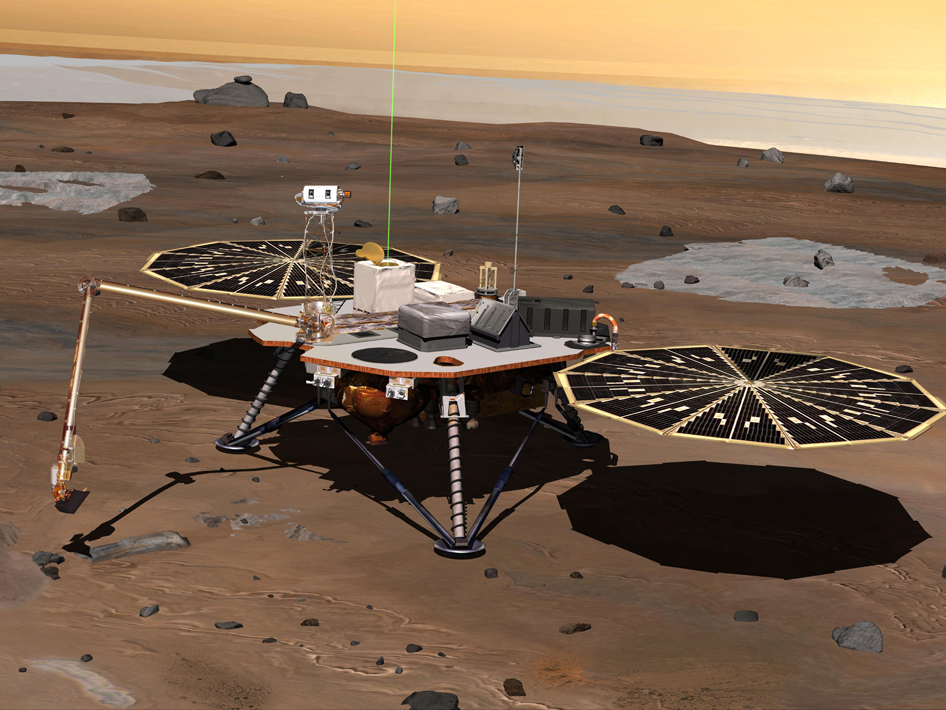[/caption]
All the best sci-fi films have them, and they may become our future automated space explorers. Currently, one of the biggest drawbacks for using robots in space is that they depend on human input (i.e. commands need to be sent for every robotic arm motion and every rover wheel rotation). This means that, especially with missions operating far from Earth (such as the Phoenix Mars Lander and Mars Expedition Rovers), very simple and mundane tasks can take hours or even days to complete. One of the main reasons supporting manned exploration of space is that very complex science can be carried out very rapidly (after all, astronauts are human and many robotic operations that take weeks can be completed in seconds). But say if our robotic explorers had a high degree of automation? Say if they could sever the requirement for human input and carry out tasks with intelligent reasoning? As robotic and computer technology increases in sophistication, one Caltech scientist believes space exploration by artificial intelligence is closer than we think…
I remember watching the start of Star Wars: The Empire Strikes Back thinking it was so unfair that Darth Vader and his ilk had access to intelligent space exploration droids that could fly around the galaxy, land on alien worlds and automatically seek out the rebels on Hoth (directing the battle fleet to the icy moon, creating one of the most famous and atmospheric sci-fi battle sequences in movie history. In my opinion at least). But say if we were able to build such “droids” (in fact, droid is a good description of these space explorers, defined as ‘self-aware robots’) that could be sent out into space to explore and report back to mission control without depending on instruction from Earth?
Wolfgang Fink, physicist and researcher at Caltech, believes robotic exploration of space will always take the lead, and even reverse the need for manned missions. “Robotic exploration probably will always be the trail blazer for human exploration of far space,” he says in an interview with Sharon Gaudin. “We haven’t yet landed a human being on Mars but we have a robot there now. In that sense, it’s much easier to send a robotic explorer. When you can take the human out of the loop, that is becoming very exciting.”
While Fink is encouraged by the progress made by missions such as Phoenix and its robotic arm, he is keen to emphasize that the link between human and robot needs to be removed, thus allowing robots to make their own decisions on what science needs to be carried out. In reference to Phoenix’s robotic arm he said, “The arms are the tools, but it’s about the intent to move the arms. That’s what we’re after. To [have the robot] know that something there is interesting and that’s where it needs to go and then to go get a sample from it. That’s what we’ve after. You want to get rid of the joystick, in other words. You want the system to take control of itself and then basically use its own tools to explore.”

The key attribute robots need to possess is the ability to recognize something of interest, such as a rock or crater, something that a human mind would see as a scientific opportunity. At Caltech, Fink and others are working on programs that use images for robots to distinguish colours, textures, shapes and obstacles. Once artificial intelligence has the ability to do this, if the programming is complex enough, the robot can notice something that is out of place, or a region worth investigating (such as a strangely coloured patch of Mars regolith that a Mars robot will decide to dig into).
As you’d expect, software is being tested and Caltech scientists are beginning to try it out on a rover’s navigation functions. However, the robotic decision-making is very basic presently, but NASA has taken a keen interest in Fink’s work. For example, in 2017 NASA intends to send a robotic mission to Titan, one of Saturn’s moons. In all likelihood the moon will be explored by a balloon-type vehicle. However, it would be impractical for such a vehicle to depend on commands being sent from Earth (as it would take more than an hour for communications to transmit over that distance), so there would need to be a certain degree of automation built into the craft so fast decisions can be made in a dynamic environment such as Titan’s atmosphere.
Although this is all interesting and necessary, there will still be a basic human desire to explore space via manned missions, although a certain degree of self-awareness may be required of our robotic explorers as they carry out reconnaissance trips before we make the trip…
Source: PC World


anyone ever think of just sending a camera?.
I mean nothing else just a camera so that we could at least see whats going on out there….
Using intelligent robots also makes it a lot easier to avoid contamination of the target environment with earth life.
Fine, this is a good first step. I only hope these robots will be equipped with efficient stereoscopic cameras, not red and blue obsolete one, so they can take good quality color pictures for public distribution.
BTW, any one interested in converting all the red and blue junky pictures from NASA to stereoscopic pictures, I just posted the instructions at UTUBE, and there is a huge amount of these photos at their archives, some of them when you convert them to stereoscopic pictures will give you interesting pictures, not given in regular photos.
It may turn out that instead of organic humans colonizing the Solar System and beyond, it will be robotic “humans” that do it, where robotic explorers become steadily more advanced until they’re sentient enough to actually be considered humans (at least in the legal sense of possessing rights equivalent to those of humans). Or it could be actual humans that have been made inorganic through gradual replacement of organic brain tissue with cybernetic components.
Given how much easier it is to maintain robots in space compared to organic humans, it might even be more likely.
LLDIAZ
NO WAY NEVER !! 🙂
nasa corporation Space ? i dont think so
Sending “just” a camera is the whole idea. Just think of it as sending different generations of cameras.
For instance. First you send a camera that takes a few pictures and sends them back. Then it waits for more commands on what to take a picture of next.
Next Generation may continually stream pictures back simultaneously listening for new commands.
Next Gen after that may be able to “guess” at what would be interesting to take a picture of.
Keep improving that simple “camera” and after many generations, you may “just” end up with C3PO (or possibly the Terminator)
But isn’t it dangerous to give intelligence to robots ? I mean, Matrix totally freaked me out.
Someone explain pls.
“The key attribute robots need to possess is the ability to recognize something of interest, such as a rock or crater, something that a human mind would see as a scientific opportunity.”
Yes, but that could mean that the robot decides that its own rear end is something of interest, resulting in a mobius loop where the robot’s viewer would be eternally stuck up its own rear end. What a shame that would be.
Once we get a lander’s baking martian soil nailed down, I might be convinced that this sort of thing is “closer than we think.”
’till then, the mobius event seems more probable…
Nice (-:
Or should I say “Nice :-)”
🙂
Hmmm, one more time….
“Nice! :)”
Of course, the Star Wars universe also has inexpensive, FTL interstellar travel and inexpensive, human-capable AI technology….
Their probes (which, somewhat like a Predator drone) were serching for rebel activity and with the express purpose of sending humans (or other biological species) in to follow up on any sightings.
I’ve always said that as long as we don’t have advanced AI or FTL communications, thre will continue to be a place for humans in space exploration.
Roomba would love Mars — all that dust to sweep! 😉
BTW, on a serious note, too many make the assumption that if we can *explore* space using intelligent robots, then we *must* eschew human colonization of other worlds. Why? If we follow that dictum, we close all doors to an unparalleled freedom, inconceivable mineral wealth, and, ultimately, a means for Earthly life — including human life, or rather, the lives of humanity’s descendants — to survive whatever ugly misadventures Earth suffers in the future. Certainly, by doing so we would be avoiding putting ourselves at risk of the perils of the Great Unknown, at least that Unknown that begins where Earth’s atmopshere stops, 400 miles above our heads. But we would also be turning our backs on all the wonder, wealth, and, yes, glory that awaits out there, beckoning — not to mention the possibility of a real future for Earthly life. Is *that* what people like Stephen Weinberg are so afraid of?
Politicos and NASA aren’t going to like this droid thing. Not enough “pork.”
It will start a new era of human beings.May be in universe Aline comes to know that the inteligent civilisetion is waiting for friendship with them.
It takes 10-20 years to get laboratory robotic technology certified for space. So the space robots of 2020 will have capabilities we are testing today.
At best they wil be able to do specified basic tasks like surveying, moving, drilling, loading samples into canisters for return to Earth. No true self awareness. No ability to guess what might be interesting.
Calling such machines “droids” evoking images of the self concious, self aware, and full autonomous entities of Star Wars is yet another example of the continously overhyped capabilities of robots. We have been are promised human or super human capabilities within 10-20 years for the past half century, and are no significantly closer to the goal than we were in 1958. “Droids” as explorers are fantasy, and are likely to remaind so for a long time to come.